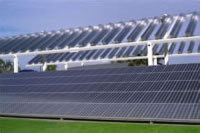
![]()
Near- and long-term production scenarios for hydrogen delivery when the fueling station functions simply as a dispensing (or pumping) station are as follows:
Scenario 1: During the transition period, hydrogen would be made in large-scale central facilities using fossil fuels such as coal or gas wherein carbon dioxide can be sequestered efficiently and cost effectively. Steam methane reformation (SMR) of natural gas is the benchmark technology for hydrogen production in this category. Another prospective near-term technology for production of hydrogen is integrated coal gasification combined cycle process. Hydrogen can then be transported to fueling stations, in gaseous state, via pipeline. Alternatively, hydrogen can be shipped on the highway via tanker trailers, in liquid state either as liquid hydrogen or in the form of a liquid or solid chemical hydride that liberates hydrogen onboard through thermolysis (e.g. methylcyclohexane), or reaction with water (e.g. sodium or lithium borohydride). The preferred mode of hydrogen transport (i.e. via pipeline or tanker trailers) is dictated by the economic and other considerations (e.g. safety, etc.).
 |
| PV arrays at Sunshine Transit Agency, Thousand Palms, CA. (Photo: L. Eudy) |
|---|
Scenario 2: In the long term, hydrogen would have to be produced using renewable resources (solar, biomass, wind, etc.) and/or nuclear energy that do not produce or require carbon dioxide sequestration. Again, renewable- and/or nuclear-based hydrogen production can occur in large-scale facilities that can utilize the economy-of-scale to boost efficiently and cut costs. Thermochemical water splitting cycles present one such hydrogen production technology in this category. As before, hydrogen can then be transported to fueling stations via pipeline or on the highway via tanker trailers, in liquid state. Again, the preferred mode of hydrogen transport is dictated by economic, safety, and other considerations.
Near- and long-term production scenarios for the forecourt hydrogen delivery when the fueling station acts as both the hydrogen production and dispensing facility are:
Scenario 1 : In the short term (during transition period), hydrogen would be made, in a distributed manner, using grid electricity produced in large power plants from fossil energy sources such as coal and/or natural gas with concurrent CO2 sequestration or non-carbogenic energy sources (nuclear and hydroelectric power). Hydrogen is produced and stored on-site by grid-electrolysis of water at the fueling stations. This will be a plausible scenario for hydrogen production only if future automobiles require pure gaseous hydrogen. In other words, until cost-effective and energy efficient small-scale hydrogen liquefiers are available, production and simultaneous liquefaction of hydrogen at fueling stations are unlikely to occur. Similarly, it is not going to be practical to produce hydrogen via grid-electrolysis on-site and then synthesize from it (i.e. regenerate) chemical hydrides, at small-scale, from spent fuel collected at the fueling stations. Another impractical method for forecourt hydrogen production, already experimented with in the U.S., Germany, Spain and elsewhere, is to use SMR of natural gas pipelined to the site. This technique is not viable because there are no cost-effective methods for small-scale sequestration of carbon dioxide generated at the fueling station. However, if methane at the fueling station is biogenically generated, SMR process could be used for its conversion to hydrogen. Examples of biogenically generated methane include landfill gas and from biomass fermentation or gasification processes. Another exception to this rule is a process under development at the Florida Solar Energy Center for thermocatalytic conversion of natural gas (and other hydrocarbons) to hydrogen and carbonaceous products (solid residue that can be readily sequestered).
Scenario 2 : In the long-term, energy carriers (electricity and hydrogen) will have to be generated from sustainable (e.g. solar, wind, geothermal, etc.) resources. Under this scenario, electricity would be generated and fed into the grid at large-scale central facilities such as solar power towers that utilize economy-of-scale for efficient and cost effective production of electricity. Again, hydrogen would be generated and stored on-site using grid-electrolysis of water at the fueling station. As discussed above, this will not be a practical method for hydrogen production if the future automobiles run on liquid hydrogen or chemical hydrides (that need regeneration from spent fuel) instead of pure gaseous hydrogen. However, it is quite plausible that hydrogen production can take place at the fueling station via PV-electrolysis of water. Although PV-electrolysis may become practical (since the efficiency of photovoltaic devices continues to improve and costs come down), in most cases the electricity generated by PV is much too valuable to be used for hydrogen production. This is because PV power readily matches the air-conditioning peak load of the utilities.
This text was originally published in IEEE Power & Energy, Vol. 2, No. 6, Nov-Dec, 2004 pages 42-44 "Hydrogen: Automotive Fuel of the Future" by FSEC's Ali T-Raissi and David Block
